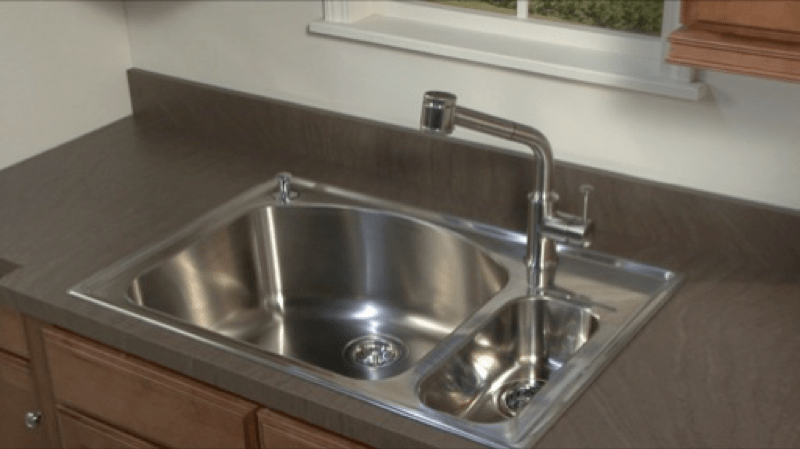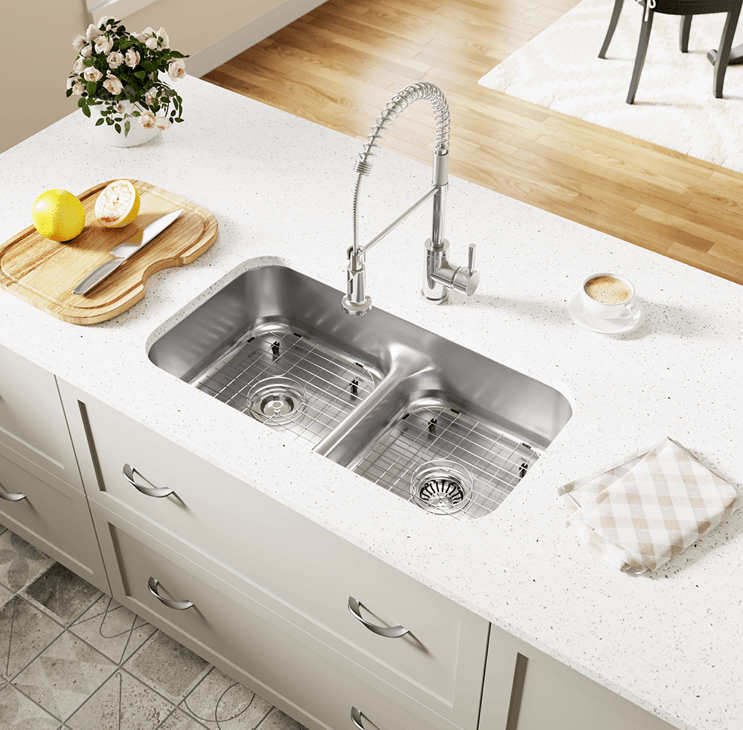Choosing the perfect sink for your kitchen is one of the most important decisions to be taken during your kitchen interiors revamp journey. Sinks are an important part of the kitchen work triangle, so size and functionality, cleaning, material must be delved into. Here, we will walk you through all the options to enable you make the ideal choice.
Consider configuration
Today a kitchen sink is being used for different multi-tasks, so they have ceased to be a single basin. Single-bowl sinks were mass produced and most common, a large, single bowl makes it easier to wash large pots, pans and cutting boards. But those who are multi-tasking it’s not possible to wash, rinse, drain and dry dishes with just one bowl. But on a practical side, this type of kitchen sink suits nearly all kind of kitchens and the best option was single-bowl sink with countertop drain-board as it makes hand washing dishes easier and neater. The countertop drain-board with grooves, called runnels permits you to rinse and then set utensils aside to dry.

The offset-style kitchen sink has two basins, one large and one small, and allows you to prep for cooking and wash up in the same space. These are better for smaller kitchens, where countertop space may be scarce.

Finally, the half-and-half kitchen sink is ideal for homes that tend to entertain and simply use a lot of dishes, therefore this sink has two equal-sized basins to accommodate more pots and pans.

Best sink shape
Sure, you won’t be installing a fancy marble sink, but the shape of your it still matters. Many homeowners find that sinks with rounded edges are easier to clean because dirt and food don’t get stuck in corners.
Newer sinks hit two birds with one stone by displaying crisp top edges and rounded bottom corners. This type of kitchen sink, combined with an attached drainboard, is the ideal choice for homes of any kind. However, ensure you have enough countertop space to fit it!
WHAT IS THE BEST KITCHEN SINK SHAPE?
Classic kitchen sinks are square or rectangular, but if you are planning a small kitchen, you might like to choose a circular sink, which saves on worktop space, although most come without a drainer. Another option is a corner sink, which can help you design a more efficient room layout.
Smaller sinks aren’t just for small kitchens: they will be handy buys if you are planning a utility room, too.
A shot of the kitchen sink, fitted in a marble-effect worktop over deep blue kitchen units
Zone In On the Right Material
Stainless steel is everyone’s go-to when it comes to choosing a sink. It’s durable, long-lasting and virtually indestructible. If you have hard water coming out of your taps, you’ll likely see water stains forming, but that won’t affect the use of the sink much.
Porcelain sinks sit better in vintage-style kitchens or those channelling a farmhouse aesthetic. Beware of chipping though! Stone and granite are also aesthetically pleasing choices, but they can prove to be expensive and high-maintenance in the long run.
Also Read
Which Is The Best Kitchen Sink Material?
Stainless steel is a practical choice that’s hardwearing, long lasting, and easy to clean, although they can dent if heavy objects are dropped on them and, over time, will be covered with fine scratches. Sinks in stainless steel are an affordable option and can add contemporary flair to a kitchen worktop. Usually available in a range of finishes: polished; silk; brushed; and linen. Read our guide to cleaning stainless steel.
Composite sinks are made from a combination granite stone dust and acrylic resins, are designed to have the looks of granite without the price tag, although they are more expensive than stainless steel and ceramic sinks. Ideal for contemporary kitchens, they can withstand high temperatures, are incredibly hardwearing and are hygienic, although they can be discoloured by harsh chemicals. The various stones used in their composition means that there are a lot of variations in colour and texture.
Ceramic is traditional and will suit any kitchen style, but especially country style kitchens, Shaker kitchens and farmhouse kitchens. Ceramic sinks can become stained over time; but with good care, ceramic sinks can be very long lasting.
Concrete is a beautiful material for a kitchen sink, albeit expensive. Available in its natural colour, it can also have pigments and aggregates added to create a variety of finishes and colours; it can also be polished to a high gloss, and treated for ease of maintenance, although it will, nonetheless, develop a patina as it ages.
Corian is another top end, but stunning material for a kitchen sink. Highly durable, stain resistant, hygienic and easy to maintain, sinks in this material come in a range of colours and styles, with a variety of edge treatments, inlays, configurations and fitting options available, including a ‘moulded’ where the sink is a seamless continuation of your kitchen worktop.
Accessorise with Practical Taps
Taps may seem like an easy enough style decision, but they can make or break your experience. Even if you go for the classic two-knob tap, consider installing an extendable spray or shower arm– this will help clean out far corners of the sink and fill large pots easily.
MATCHING YOUR KITCHEN SINK TO TAPS
Kitchen sinks come ready prepared for mounting to certain faucets. Make sure when choosing your taps, they match your sink, and vice versa.
Maintain Standard Heights
The sink and countertop were the first elements of a modular design to get standardised. However, the kitchen counter height may vary according to the height of the person using the kitchen. Between your elbow height and countertop, there should be an approximate gap of 15cm. Subsequently, the sink is almost always the same height as the kitchen counter height for obvious reasons. However, the ideal depth of a sink is 56 cm.
Designing a kitchen can be a nerve wracking experience, but knowing your options beforehand will make it that much easier to cross tasks off your list!
HOW TO CHOOSE THE BEST KITCHEN SINK SIZE
The most important factor in choosing your kitchen sink will be its size. The bigger the kitchen, the more freedom there will be to add drainage boards, second and third basins, half basins and waste disposals.
Built in drainage boards are common on both composite and stainless sinks. While ceramic draining boards are available, they are likely to be damaged through frequent use.
WHICH KITCHEN SINK CONFIGURATION?
Single bowl sinks, usually combined with drainers, are ideal for small kitchens, offering plenty of space in which to wash big pots and pans. They usually come with a drainer section where you can leave dishes to dry.
1.5 bowl sinks have a small bowl next to the main sink bowl and are ideal for extra washing or draining when the main bowl is in use.
Two bowl sinks are really useful in family-sized kitchens.
All bowl configurations can be surface-mounted, inset and come as Belfast or butler sinks; each can be used with any worktop material.
CHOOSING THE BEST DRAINER OPTION
Most inset sinks come with a drainer included. Under-mounted sinks can either sit within a worktop and you can buy a dish rack; better still, a drainer can be factory-cut into the worktop material.
Universal drainers can be positioned either side of the bowl. These sink/drainer combinations come with two holes cut in the sink top, one front and one back. The tap will be fitted through one, the other will be sealed with tap hole stopper.
Left-hand drainer/right-hand bowl or right-hand drainer/left-hand bowl: with these sink/drainer combinations, you need to get the configuration right when you order.
Where to position the drainer? It’s usual to position it over an appliance, such as a dishwasher, but ideally you need to consider how it fits into the worktop and preparation space overall before deciding.





















